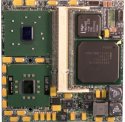High integration Pentium M 745 SBC supports Linux
Jun 22, 2004 — by LinuxDevices Staff — from the LinuxDevices Archive — 5 views General Micro Systems (GMS) has announced what it claims to be the first single-board computer (SBC) based on Intel's new Pentium processor for the embedded market, the “Pentium M Processor 745” (formerly codenamed “Dothan”). GMS also claims its compact new SBC, which measures 4 x 4 inches, is the world's smallest full-featured Pentium M SBC.
General Micro Systems (GMS) has announced what it claims to be the first single-board computer (SBC) based on Intel's new Pentium processor for the embedded market, the “Pentium M Processor 745” (formerly codenamed “Dothan”). GMS also claims its compact new SBC, which measures 4 x 4 inches, is the world's smallest full-featured Pentium M SBC.
The P60x can be used in a standalone fashion, or mounted on a single-slot carrier card such as 3U/6U CompactPCI, VMEbus, ATCA, or a custom board. Additionally, the SBC's tiny form-factor enables OEMs to place it close to the point of control, greatly increasing distributed control performance and reducing cabling complexity, GMS says. The SBC's small size also makes it ideal for building high-density, multi-module blades. In such applications, the board's small size and modular architecture enable integrators to take advantage of more powerful CPU, memory, and I/O facilities by swapping in enhanced versions of the board in the future, with minimal impact on existing infrastructure.
The P60x features a soldered-down 1.8-GHz Pentium M Processor 745. Boards based on faster Pentium M processors will be offered as the processors become available. The Ultra Low Voltage (ULV) processor consumes just 12W when operating at full speed, and 7W under typical operating conditions. The board also utilizes the rest of Intel's Embedded Roadmap Pentium M chip set, including the 855GME System Controller, Enhanced Rapid I/O Hub Controller, and 82546 dual-Gigabit Ethernet controller. Intel's Embedded Roadmap guarantees minimum five-year availability for each of these components, a key requirement for embedded applications such as defense, telecom, and industrial control which require long product lifecycles, according to GMS.
The board is equipped with two megabytes of L2 cache, one gigabyte of SDRAM, two Gigabit Ethernet ports, and four video outputs: RGB with 64MB of RAM and 2D/3D acceleration; 4x AGP video bus; LVDS for flat panel displays; and DVI-D for Digital displays. It also features two Ultra DMA-100 IDE ports, two Serial ATA ports, four USB 2.0 ports, two serial ports, AC-97 Audio, 21 GPIO lines, up to 16 MB of BIOS/user flash, and a large CPLD that can be used to create custom I/O options.
For expansion purposes, the P60x provides four independent I/O buses: a PCI-X bus for access to high-speed system I/O devices; a 32-bit, 33 MHz PCI bus for access to low-speed user devices; an LPC bus (Low-Pin Count, formerly known as ISA bus) for access to Flash memory and other slow devices; and an SMBus bus for control and status.
Though similar in size to the ETX form-factor popularized by JUMPtec (now Kontron), the P60x is built in a nonstandard form-factor. GMS says ETX can't fit on 3U form-factor carrier boards, whereas the P60x can.
Software support for the P60x includes Linux and several other popular embedded operating systems.
This article was originally published on LinuxDevices.com and has been donated to the open source community by QuinStreet Inc. Please visit LinuxToday.com for up-to-date news and articles about Linux and open source.